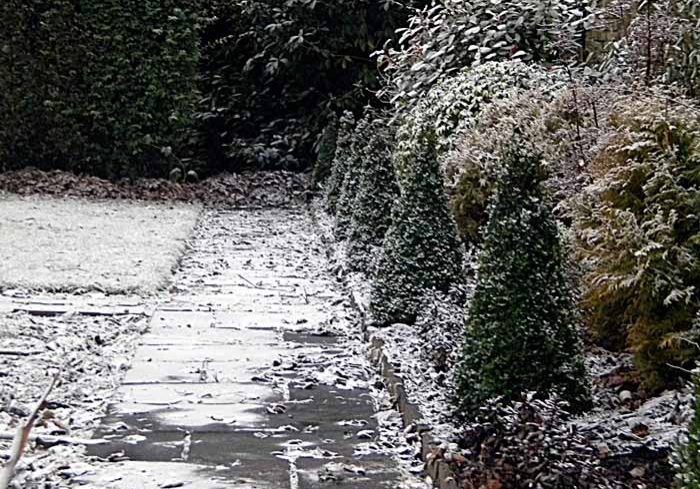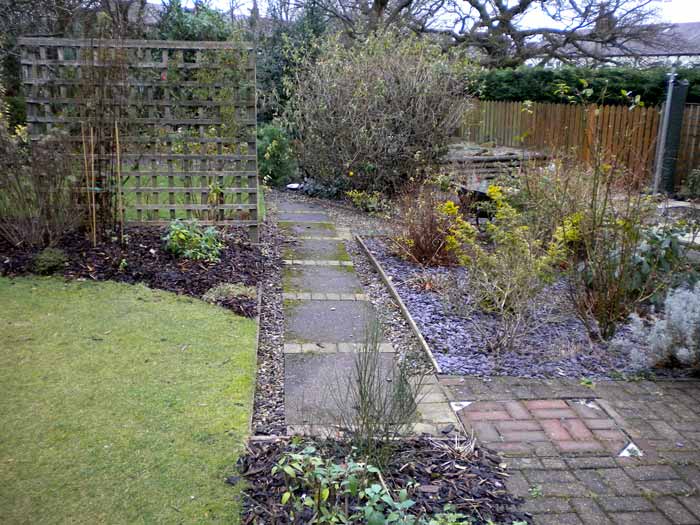
The trials and accomplishments of gardening in Winter
by Northern Life
Take a Long, Cold Look
Hello once again, as we peer through the murky depths of winter for an article which aims to guide you through the trials and accomplishments of the garden throughout the season.
At this time of year, the weather is often grim or sometimes it is cold and clear, but whatever the weather we can bring some positivity to the garden by looking at the structure of the garden so we might improve it and make the garden more effective or perhaps more usable for the coming season. So let’s bat away the drab feelings and remove the urge to stay in where it is warm and get out in the garden to investigate and improve the structure of the garden while nothing is growing and we can actually see what is in the garden.
“What is garden structure”? I hear you say. Garden structure is a combination of three areas of the garden which also cross over with each other. It is most obviously the paths, walls, borders, lawn, patio and other specific areas that make up the garden.
However, it is also to do with how these areas are laid out in relation to one another and how they interact with each other as well as how effective or useful they are. Lastly it is the how these items are laid out or made up. For example: Are the paths gravel and stepping stones or solid paving? Are the borders fully planted or partially planted with features such as ornaments or statues within them?
So as you can see, the structure of the garden is one big part of the garden but it is also three areas which intermingle and this is what makes or breaks a garden. What do I mean? Well if the structure of the garden is badly laid out or made up in an indiscriminate way it makes the garden difficult to use or unpleasant to look at.
However, if the structure is well laid out and is made to flow easily round the garden it becomes a pleasure to use and a joy to behold. This is where we start our investigations.
In mid winter – where we are at the moment – there is the least amount of plant growth and therefore it is easiest to see throughout the garden and observe the structure of the garden. So have a look round and take note of what structural items make up your garden – patio, lawn, borders, paths etc – then have a look at how they are laid out or interact with each other. Do the paths have a purpose and lead to something? Is the patio in a place that can be accessed and which best suits what you use it for? Are the walls serving a purpose and are they in a useful place? Are the borders
well placed and the right size?
Have a look at all these and any other items making up the structure of your garden, then decide if they are serving the purpose they need to and if they are as accessible as they need to be.
Once you know what is in the garden and whether it is providing the right benefits, you can start working on improving or changing the structure. If you find that there are areas of the structure that are not right – a badly shaped border or lawn, a path that leads nowhere, a patio that is difficult to access, a wall with no purpose – you must concentrate on rectifying them first. If you find that you are happy with the way your structural items interact and provide their purpose, then you can look at altering the structure to suit a particular style you like. Or, to make the garden even
more effective, you can always change part of the garden structure in this process if you find it doesn’t work for what you want to do.
To rectify one or more items in your garden structure, make sure you know which ones are working and which are not, then look at the ones that do not work and decide what they are for. Is the
lawn for sitting on, looking at, playing on? Is the patio for entertaining, relaxing or a space to work? Where do you want a path to take you and what is it for? What sort of plants will go in the border? Does it need to be accessible, is it for display or tending to?
[interaction id=”566051c2b8db3ddc5ec6164b”]
As you decide these factors for each item that needs changing, they will begin to suggest where they should sit in the garden or how they should look. A patio for entertaining needs to be near the house; one for relaxing should be surrounded by borders and other features. A lawn to look at can be an unusual shape; a lawn to use should be a simple or uniform shape. A path to a shed or greenhouse could be paved for ease of access, while a path through the garden may be stepping stones or gravel for decoration. This will then suggest whether the item should be moved from its current location or simply upgraded. Once you have been able to decide the use of the particular item, where it needs to be in the garden and how it should be made you can move onto rectifying that area.
If you have found that all the areas in your garden are suitable and have the correct purpose, then you can look at altering them to create a particular garden style; Japanese, woodland, contemporary, traditional, sensory etc. Your style will suggest ways in which your areas should interact and be made up. Japanese gardens are largely gravel and rocks with occasional and specific plants; woodland gardens are natural bordering on wild using bark and groundcover plants; contemporary gardens have bold clean lines, are minimalistic and stark – so you should use materials and shapes that suit your particular style.
You may wish to make your garden more effective for you rather than follow a particular style. If you struggle with movement or are disabled you may wish to create raised beds where they were once flat; if you’re an avid food grower you may wish to create veg, soft fruit, bush fruit and herb beds; if you don’t do much gardening you may wish to turn your garden to patios, paths, and borders with mulch to reduce the work that is required. Whatever your decision about your garden, you will find that what you wish to create will suggest how the structure of the garden will work.
I hope you can see from this brief insight into the structure of the garden that it is much easier to tackle it in winter when the garden is clearer and easier to see but I also hope that it helps you
work out what is required in your garden to make it much more effective or pleasurable to use and that you can see it is not as complicated as it may seem. Join me next time when we shine the spot light on spring preparation including spring pruning and dividing perennials.
It just remains to say the most important bit – I’m Geoff Moss – the only moss you want in the garden’.








